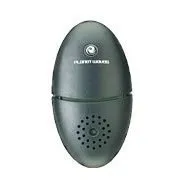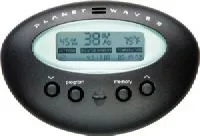
Ideal for keeping the case humid in dry conditions.
Retails at around �12

It is necessary to keep a check on both.
Retails at around �25
General
Stringed
Instrument Care and Tuning
Acclimatisation: When receiving a new instrument, bear in mind that it may have been built or restored in a very different climate to your own. It should be acclimatised very slowly to the new environment. Keep in a case/box when not in use. For instructions in converting a posting box to a serviceable case, follow the Box-building link.
Tuning: Tune up slowly, and make sure you have a pitch pipe or tuning meter handy, and that you know the correct tuning so you don't over tighten the strings. All old instruments should be strung with only light gauge strings, as they are fragile to varying degrees because of their age.
Buzzes:
You may find there is a metallic rattle on the odd string when
you first tune them up, particularly
when changing strings.
check that the
cover on the tailpiece is not touching the strings, if it is, bend it up.
where there
is a zero fret, check that the slot behind the fret not to be cut deep enough
for the string to touch the zero fret. The slot can be deepened with a penknife
or a needle file. Where there is no zero fret, check the nut slots as below.
the slots on the bridge saddle may not fit the string exactly. First check the bridge is in the right position (see intonation), then slacken the string, examine string seating with a hand lens, the saddle should stop the string cleanly. Adjust with a small file and tune up and re check.
Intonation:
Relative Humidity:
Keep a check on the relative humidity. Keep the humidity in the case/room between 45%
and 55%. Remember this will be changed by the outside temperature as well
as the humidity.
| Old Italian mandolins especially need to have humidity controlled, as there is no protective varnish on the tops of most. It will also be necessary for many other instruments, to ameliorate the differences between temperature and humidity changes from season to season. | |||
 |
This is a 'Planet Waves' small case
humidifier designed to fit in small instrument cases.
Ideal for keeping the case humid in dry conditions. Retails at around �12 |
 |
This is a 'Planet Waves' temperature and
humidity meter, small enough to fit in a case.
It is necessary to keep a check on both. Retails at around �25 |
Cold
or Dry
Conditions:
The heating is often on when it is cold, and cold air can hold less moisture. This is when humidity can drop to dangerous levels. (Below 40% at 24*C) Wood will shrink in very dry conditions, and cracks may appear in your instrument. Particularly in softwood parts such as the top. In very dry weather always keep your instrument in a case, with a bowl of water next to it to keep up the humidity.
Heat:
Damp
& High Humidity:
Moisture Content: Wood for instrument construction is dried to a 6-8% "moisture content" in the US, whilst in Europe to 12-15%. To maintain this level of MC a relative humidity of 45% is needed, or 55% for European instruments.
| Possible Effects of Indoor Humidity | |
| Winter: cold, central heating on full | Spring, Summer, Autumn: damp, warm |
| Less than 30%, TOO DRY | More than 60%, TOO WET |
| Damage to wood floors, furniture, MUSICAL INSTRUMENTS | Termites, cockroaches, and other insects |
| Static electricity; electronic equipment damage | Condensation and stains on walls, ceilings, windows |
| Increased dust | Flaking paint and peeling wallpaper |
| Respiratory, throat, and skin irritations | Mold, mildew, dust mite growth; allergic reactions |
| My instruments are made and repaired in an ambient humidity of around 45-55% in my humidy-temperature controlled workshop. | |
For assistance or problems with an instrument, contact me.
Enjoy playing, I do, Dave Hynds